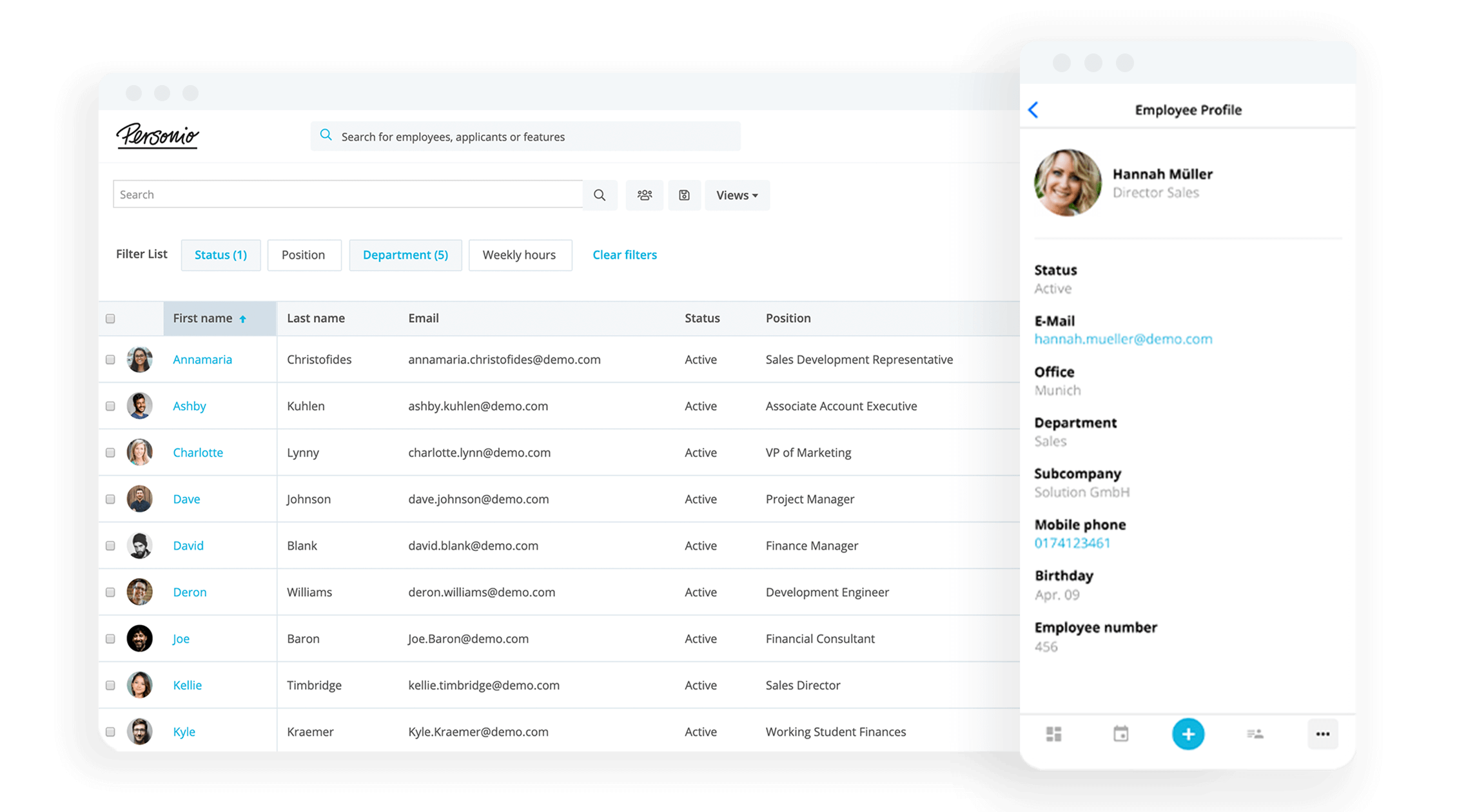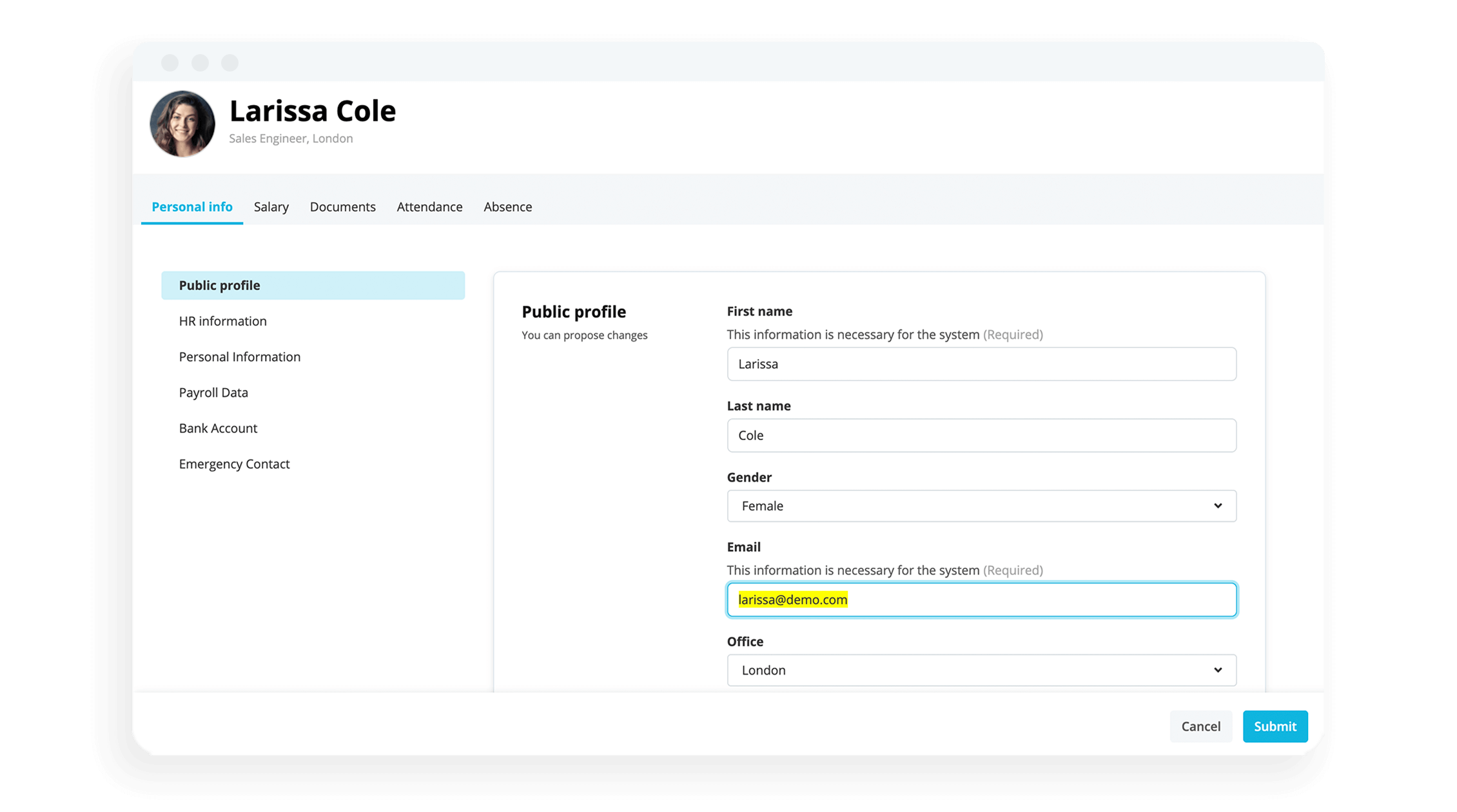Hybrid Working: Our Guide To Post-Pandemic Success

Have you made hybrid working a priority at your organisation? For companies of all sizes, everybody wants to know how to make a hybrid work model a real success. In this comprehensive guide, we outline all of the resources you need to make sense of hybrid working, how to consider it for your company, and then how to make it a success (through helpful guides and automating your core HR tasks).
Start hybrid work from a place of strength. Discover Personio today.Contents
- 1What Is Hybrid Working?
- 2The Benefits of Hybrid Working
- 3Can Hybrid Work Hurt Or Help Company Culture?
- 4Is Hybrid Working Likely To Stick Around?
- 5What Is A Hybrid Working Model?
- 6Does Your HR Team Need A Hybrid Working Policy?
- 7How Do You Manage Hybrid Teams?
- 8Consider This: Hybrid Working Policy Template
- 9The Future Of Work Is Through Digitalized HR
What Is Hybrid Working?
Hybrid working, as part of a hybrid model, is a company's arrangement for employees to spend some of their time in the office, working from home, or working elsewhere in some capacity. Essentially, it is a blend of in-office and remote working opportunities, designed to help employees be at their most productive, at all times.
According to research performed by the CIPD, working from home on a regular basis (a key element of hybrid working) is set to roughly double from 18% to 37% following the Covid-19 crisis. That same study found that employers recognised that employees would be working from home 22% of the time, up from 9% before the pandemic.
This speaks to the fact that hybrid working has become more and more the norm, not only by necessity but by preference. Employers recognize that they will need to have some sort of model because employees demand it. But, is hybrid truly better for business?
Is Hybrid Working The Same As Agile Working?
Yes, and no. Hybrid working benefits from the same philosophical idea as agile working, but it is a little less decentralized. Agile working, as we detail in this guide, is a recognition that work can happen just about anywhere.
Hybrid work, on the other hand, is a bit more of a binary between working from the office and working from home. While some companies will introduce more nuance into this mix, many will simply outline two options.
So, while HR teams may approach hybrid work and agile work the same way, they will ultimately have different considerations (we’ll detail those for hybrid work later on in this article).
The Benefits of Hybrid Working
The Covid-19 pandemic made working from home mandatory, and likely many businesses saw it as potentially damaging to their business.
The acas begins by outlining some of the most basic benefits of hybrid working, including an increase in productivity and job satisfaction, the ability to attract and retain a more diverse and varied workforce and to improve trust and working relationships between employees.
Employees benefit from hybrid working because it affords them to be productive on their own terms. They can identify and work within their own unique working style. After all, you can’t fit all your employees into one single bucket of ‘working style.’
Instead, hybrid work affords employees the opportunity to discover what works for them. For example, a working parent may benefit from being home a couple more days a week, not only to see their children but to maintain their home so as not to come home to chaos.
On the other hand, a more junior employee may see a great benefit of coming into the office. Not only for the social connections but the networking opportunities. They may see ‘chats around the watercooler’ as truly invaluable.
In that sense, hybrid working helps with:
Employee autonomy
Role responsibilities
Work-life balance and employee wellbeing
One HR Solution For Your Hybrid Working Needs

Personio’s HR software offers a single source of truth for all of your employee data, policies, and so much more. Click the button below to learn more about how it can help your team today.
How Personio Can HelpCan Hybrid Work Hurt Or Help Company Culture?
Many organizations may worry that hybrid work may put a dent in their company culture, as employees may no longer come into the office and connect with one another. But, as we learned throughout the course of the pandemic, company culture is alive and well.
So, hybrid work can do one of two things: It can boost your company culture by emphasizing trust, autonomy, and responsibility. Employees may feel more connected than ever to your company, even if they are not in the office every day.
On the other hand, a lack of hybrid work can also expose your type of culture. It can make employees feel like they aren’t being trusted, they are being watched, or that their sense of responsibility is being restricted to a dangerous degree.
Especially in line with current employee expectations, it would seem that a lack of hybrid work may be more damaging to your culture than not having it at all. This may also feed into a ‘talent exodus,’ profiled in our latest HR study.
Download our complete guide to corporate culture today.
Is Hybrid Working Likely To Stick Around?
All indications are that hybrid work is the way things will be for quite some time. In one of Personio’s recent webinars: "Remote Working: Here To Stay Or On Its Way Out?” We sought to answer that very question.
Our panel of experts agreed that remote-first principles will remain, to help facilitate a shift back into the office, while workplaces, in general, will become more spaces of “inspiration and collaboration” for workers who benefit from that.
Last, but not least, hybrid working will stick because employees demand it. A recent study from Stanford University found that 22% of working days are likely to be done at home, compared to 5% prior to the pandemic. In short, employees want hybrid work.
What Is A Hybrid Working Model?
A hybrid working model is a policy or procedure that a company puts together to express its philosophy or rules around the concept. In its most basic form, we can think of a model as a split between remote and in-office working (70/30, 50/50, etc.)
And since 67% of UK workers prefer a hybrid working model of some kind, having one in place, and soon, is table stakes for many companies. That means knowing whether or not your company is ready to hit the ground running with hybrid work.
So, does a hybrid model suit your organization? We recently tackled this topic in an article from Personio’s Chief People Officer, Ross Seychell, entitled “Does A Hybrid Work Model ‘Work’ For Your Organization?”
In it, he offers a scoring system to come to the conclusion of whether or not your organization is ready for hybrid work. And, what you might want to consider, and in what critical areas, to make the transition process that much easier.
The first step may require a proper people strategy in place. Download our guide.
Discover Personio: Secure Your Employee Data

Ensure that your employee data is safe, while still being accessible. Discover Personio’s Digital Employee File feature today. Click the button to learn more.
Secure Your Employee Data With PersonioDoes Your HR Team Need A Hybrid Working Policy?
As the CIPD notes, “hybrid working is a form of flexible working.” So, if your company has a flexible working policy in place, that should be your first place to start. But, for it to be successful, you will need something written down somewhere.
It’s what informed our recent process at Personio, and how we introduced our concept of PersonioFlex. In order for our team to live our core value of #Transparency, we needed every employee to know what is expected of them and how hybrid work looks within our organization.
But, when developing a policy around hybrid work, what should your team consider? Here are some of the most common things to keep in mind:
What split are you aiming for? Will you have one at all?
What does ‘working from home’ mean for your organization?
Are all employees eligible for your working from home policy?
How will you track working from home? Will you track it at all?
What expectations will you have of both employees and managers?
How will this affect your team events or social activities amongst teams?
How will you advise teams to collaborate both remotely and in the office?
Then, there are also some key legal considerations (the CIPD does a great job of laying this out for UK employees). The main thing to consider, though, is that a hybrid policy can be a great way for your entire organization, across teams, to align.
After all, flexible working during Covid-19 was often a very lonely affair. Employees often didn’t have the choice, and they had to do their work over Zoom calls or simply on their own. Hybrid work introduces a lot of nuance into the mix.
How Do You Manage Hybrid Teams?
Because teams can now be mixed, in terms of being in the office or working remotely, it ask a lot of new questions about managing remote teams effectively. Personio’s Head of Brand and Comms, Laura Schroeder, began this conversation masterfully in her post: “The 9 Keys To Remote Team Leadership.”
And, a lot of that advice still stands, it just becomes a bit more complex. Now that teams can be in two places at once, rather than in their respective homes, how do you make sure that teams are managed effectively?
From an HR perspective, that all comes down to preparation. Here is how you can prepare teams, and your entire business, to manage effectively in a hybrid work model:
Step | Explained |
|---|---|
Establish A Policy | As we already noted, transparency is going to be key here. Your organisation needs to have a hybrid working policy in place, especially if you want employees to understand and follow any rules you may have. |
Identify Key Metrics | How will you track if employees are truly taking to hybrid work? You’ll need to have an idea of your HR analytics and reporting, as well as some of the key metrics (employee engagement KPIs can help a lot here). |
Prepare Offices | Depending on how you want to do hybrid work, you may need to clean out the cobwebs and redesign your office spaces. Will you implement a ‘hot desk’ model? What collaborative spaces will exist? |
Digital-First Processes | It’s highly unlikely that your entire organisation will be in the office all in the same day, so you need to build and encourage digital-first people processes that help your employees feel included (that means preparing for meetings Zoom-first, rather than meeting room-first). |
Encourage Feedback | Your managers are not going to need to have their finger on the pulse of employee wellbeing more than ever. Help them by facilitating feedback processes, and a place to store feedback, so managers are not overwhelmed while employees feel consistently heard. |
Find Time To Connect | Managing hybrid teams means finding time to connect both in-person and online. Help managers find opportunities to do exactly that and encourage them to find time with their reports to get together, as a team, to work as one. |
Provide Equality | Remote employees and in-office employees, or a mix between, should all feel equal to one another. HR needs to ensure this is the case, with benefits everyone can enjoy, perks unique to each type of employee, and other ways to express value for anyone (regardless of their working style). |
The last point here is likely the most important when it comes to managing hybrid teams. It is crucial that employees who simply prefer coming into the office more, don’t ‘benefit’ from being there to an unfair degree. Remote or hybrid employees work just as hard, and it is an incredibly important balancing act to make sure that is felt.
For HR and leaders alike, that means really focusing on inclusive practices and opportunities for every type of employee. The acas recommends potential training for managing remote employees, which may be the ideal place to start for many organizations.
Consider This: Hybrid Working Policy Template
Based on guidance from the acas, here is how your hybrid working policy might look at your organization:
Your company’s overall stance on hybrid working.
Any factors that will influence hybrid work (like your company core values).
How employees can request, access, or use hybrid work.
The ways managers can support and interact with hybrid employees.
Health and safety considerations.
Any performance management cycle changes.
Required or recommended training (for employees or managers).
Data security considerations and rules.
Any exceptions or roles that differ from the overall policy.
Especially since many organizations will only be at the beginning of this process, reviewing and iterating on your hybrid working policy will be more than necessary. After implementing one, shoot for reviewing it every quarter at first, and then yearly following.
This will give both your HR and executive leadership team an idea of what is working, where people may be struggling, and where changes may need to be made. It helps to be flexible here, and not too reactive, as hybrid work is an evolving concept.
The Future Of Work Is Through Digitalized HR
For teams of any size or in any industry, digitizing your HR can be the first crucial step of developing or implementing a hybrid working policy. Because, as most of your workforce may be fully online most days, your HR needs to be able to do the same.
That means having an HR software that can manage, develop, pay, and report on your employees across teams, departments, and your entire organization. It’s building a foundation of success for the future of work. Click the button below to learn more about Personio today.
Disclaimer
We would like to inform you that the contents of our website (including any legal contributions) are for non-binding informational purposes only and does not in any way constitute legal advice. The content of this information cannot and is not intended to replace individual and binding legal advice from e.g. a lawyer that addresses your specific situation. In this respect, all information provided is without guarantee of correctness, completeness and up-to-dateness.
